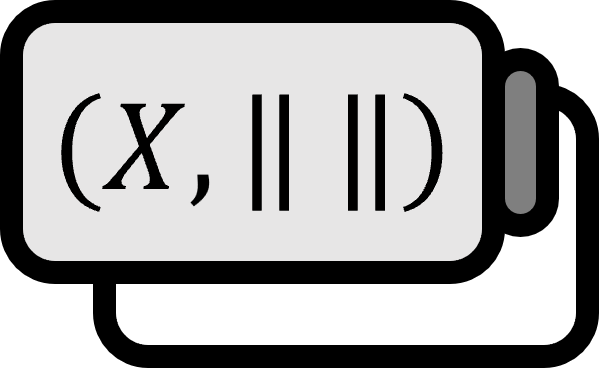Operators in Functional Analysis
Definitions1
Let’s call $(X, \left\| \cdot \right\|_{X}), (Y, \left\| \cdot \right\|_{Y})$ a normed space.
A mapping from a normed space to another normed space is called an operator.
For $x,x_{1},x_{2}\in X$, if $T : X \to Y$ satisfies $$ T( x_{1} + x_{2} ) = T( x_{1} ) + T( x_{2} ) \quad \text{and} \quad T( a x ) = a T( x ) $$, it is called a linear operator.
If for all $x \in X$ there exists a $\left\| T(x) \right\|_{Y} \le C \left\| x \right\|_{X}$ that satisfies $C \ge 0$, then $T$ is said to be bounded.
Among the $C$s that satisfy 3., the smallest $C$ is defined as the operator norm of $T$ and denoted as follows: $$ \left\| T \right\| :=\min \left\{ C : \left\| T(x) \right\|_{Y} \le C \left\| x \right\|_{X} \right\} $$
The set that collects all bounded linear operators $T : X \to Y$ is denoted as $B(X,Y)$.
Explanation
Just as a mapping from a vector space to another vector space is specially called a transformation, a function from a normed space to another normed space is specially called an operator.
For convenience in various textbooks, any function $X \to Y$ between vector spaces is called a transformation, and transformations like $X \to X$ are called operators.
From the definition of 4., we get the following:
$$ \left\| T \right\| = \sup \limits_{\substack{x\in X \\ \left\| x \right\|=1 }} \left\| T(x) \right\|_{Y} $$
This is also defined as the norm of $T$. If you don’t understand why the condition $\left\| x \right\|_{X}=1$ exists, think about 3.
An operator is algebraically a homomorphism that preserves operations, and naturally, all theorems regarding this can be used as well.
Choosing to use the term operator instead of operator is because rather than focusing on ‘operations’ like in the past, we are interested in the ‘action’ in some space, abstracting, and dealing with it mathematically. If you think about something like a rotational transformation, you can see it as moving a point by rotating it in space. Of course, it is also correct to explain that we obtain the result by taking coordinates as vectors and multiplying matrices, but if you think of it as the behavior of ‘moving’ the position of a point, the expression operator is also quite appropriate.
Thus, we can now use expressions like applying some ‘action $T$’ to mathematical objects represented as vectors in a given space. Among these, what we particularly focus on are linear operators, with examples including:
Identity operator $I : X \to X, Ix = x$
As the name suggests, it is an action that does not change or is virtually the same as not taking any action. It is also denoted as $1$ or ${\rm id}$.Zero operator $\mathbb{0} (x) : = 0$
An action that turns any element into $0$, playing the role of a zero vector in the vector space of operators.Differentiation operator $D : C^{1} \to C^{1}, Df = \dfrac{d f}{d x}=f^{\prime}$
An operator that takes the derivative, a fact that everyone has been using knowingly or unknowingly since high school.Integration operator $T : C[0, 1] \to C[0, 1]$, $\displaystyle y(t) = Tx(t) = \int_{0}^{1}K(t, s)x(s) ds$
Integration is also an operator, and here $K$ is called the kernel. It is also known as integral transform.Matrix $T_{A} ( \mathbf{x} ) := A \mathbf{x}$
A $m \times n$ matrix $A$ can be thought of as a function that goes from $\mathbb{C}^{n}$ to $\mathbb{C}^{m}$.
Ole Christensen, Functions, Spaces, and Expansions: Mathematical Tools in Physics and Engineering (2010), p37 ↩︎
